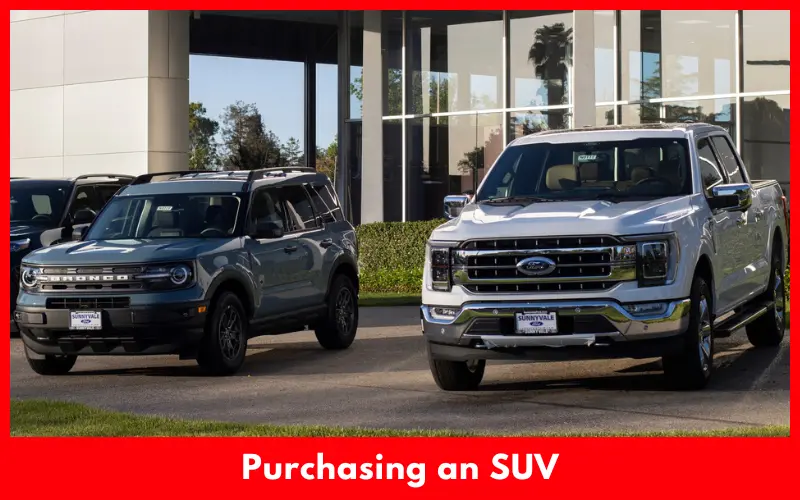When it comes to comfort and versatility, very few off-roading vehicles can compete with SUVs. They offer drivers more power and control to tackle any terrain. Most families love SUVs for their rugged images, huge interior spaces, and tall height.
However, the fact that all top motor vehicle brands have SUVs in the lineup has made it challenging for people to pick the right option.
Article Summary
What To Consider When Purchasing an SUV?
Manufacturers have also introduced electric and hybrid options for environmentally conscious individuals. Here are some key features to consider when purchasing an SUV.
Car Size and Dimension
Like most multi-purpose units, the SUVs are available in a wide range of dimensions (luxurious large SUVs and compact small options). When purchasing an SUV, you should consider your family’s needs and where you normally frequent. Remember, large luxurious units have more cargo and passenger space than smaller ones.
Large or medium-sized SUVs can make perfect family vehicles. On the other hand, the compact small-sized options are perfect for driving on paved roads. Large SUVs are seven-seaters, while the smaller ones can carry five. If seating capacity is an issue, then you should compare a seven-seater SUV with other seven-seater multi-purpose units.
These vehicles have enough space, but SUVs are all-rounded utility vehicles, while MPVs are designed to accommodate seven people from the start. People looking for seven-seater SUVs should choose a full-size SUV that can easily maneuver in town, such as the INFINITI QX80 or Cadillac Escalade.
These full-sized SUVs have the same leg and headroom for rear passengers. The cargo space of these cars varies with their dimensions, which range between 1699 and 2265 liters. In addition to their cargo spaces, you should also consider their payload capacities. The payload capacity shows a car’s ability to carry loads.
Drivability
Depending on where you reside, you may want to consider whether you need four-wheel-drive (4WD), all-wheel drive (AWD), or front-wheel-drive (FWD). The FWD is perfect for city dwellers while the AWD and 4WD are perfect for off-roading.
A permanent 4WD transmission can power through any terrain. However, if your main goal is better handling and extra safety measures while driving in adverse road conditions, then an AWD can be a great option.
Another factor that you must consider when it comes to drivability is the vehicle’s ground clearance. Generally, cars have a higher ground clearance than most vehicles, which helps them handle most rough terrain. However, the ones designed for urban use tend to have a lower ground clearance than the off-roaders.
Efficiency
Huge vehicles like SUVs need more gas than normal cars, so you should consider fuel economy when buying one. Luckily, the latest models have efficient engines that lower carbon emissions and petrol consumption. Other than the conventional options, several brands have hybrid and electric SUVs in their lineups.
A great hybrid SUV can help with fuel consumption, especially when driving stop-and-go traffic in the city. Hybrid SUVs operate on low-speed electric power, meaning less emission.
If you want zero emissions while driving, then you should go for an electric SUV like the Acura ZDX, which grants you over 325 miles per charge. Compared to gas-powered units, electric SUVs have more cargo space and legroom.
Handling
If you have never driven this automobile, one of the key things that should be on your mind is handling. SUVs’ driving positions can increase your confidence, but their size and shape mean they handle differently compared to saloon cars and hatchbacks.
This means that handling them in a small or crowded space can be quite challenging. Luckily, modern SUVs have active park assist and reversing sensors that can help you tackle parallel parking.
Lifestyle Features
You should also consider various practical things that can make your life easier while driving. These features include entertainment systems, USB ports, cup holders, and fold-out tables.
These features can make a road trip easier for your family. Remember, SUVs have a higher ground clearance than most vehicles, so the presence of a doorstep matters a lot. On top of that, a roof rack can offer you more storage space when traveling.
Safety Features
Last but not least, you should consider the safety features of any SUV over its aesthetics like design and color. While you want a comfortable SUV that can tackle tough terrains, you should select one with the right safety features. Some of these safety features include:

- Pedestrian detection and emergency braking: This braking system and people detection tech use radar and cameras to detect a potential front-end collision. If you don’t react quickly, the system will do it for you and help you mitigate or avoid a crash.
- Lane-keeping assistance: SUVs are huge vehicles that present various challenges, especially when driving. Luckily, they do have lane-keeping assistance that helps you stay in your lane. If you change lanes before clicking the indicator, it will do it for you and warm the other drivers.
- Blind spot monitoring: An SUV has various sensors that detect other vehicles in your blind spot and then inform you with a chime or warning light. It prevents drivers from making dangerous lane changes.
- Adaptive cruise control: This feature helps your car maintain a set speed, but it also monitors the speed of the cars in front of you and slows down when it does. Some SUVs come with a reliable system that can bring it to a complete halt when necessary.
Like most modern automobiles, SUVs come with the latest safety features. These features can help you avoid a collision, park safely, and drive without endangering the lives of other drivers.
Endnote
When purchasing an SUV, you should do more than check its comfort levels; you should also consider its capacity and safety features. Emergency braking systems, lane-keeping assist, and blind spot monitoring can help you prevent accidents.
On the other hand, the transmission system you pick will be determined by your driving pattern and where you plan on exploring. Remember, the consumption rate of AWD and 4WD tends to be higher than that of FWDs. The only solution for this is going for hybrid and electric SUVs, which are efficient and have lower emission levels.

